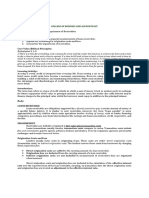Aefar 3 Intermediate Accounting: College of Business and Accountancy
Uploaded by
Jerome CatalinoAefar 3 Intermediate Accounting: College of Business and Accountancy
Uploaded by
Jerome CatalinoModule 5
Loans Receivable /Financing and Assignment
Financing and Assignment
AEFAR 3
INTERMEDIATE ACCOUNTING
PART 1
to your second module!
This module is a combination of
synchronous & asynchronous learning
and will last for two - three weeks
Course Coach
COLLEGE OF BUSINESS AND
ACCOUNTANCY C_Outline
Carmelita J. Mercado
October 25-, 2021
Date Initiated
November 10, 2021
Date of Completion
San Mateo Municipal College
Gen. Luna St. Guitnang Bayan I, San Mateo, Rizal
Tel. No. (02) 997-9070
www.smmc.edu.ph
SAN MATEO MUNICIPAL COLLEGE
General Luna St., Guitnang Bayan I, San Mateo, Rizal
Tel. No. (02) 997-9070
www.smmc.edu.ph
MODULE 5
AEFAR 3
LOANS RECEIVABLE / FINANCING AND ASSIGNMENT
MODULE SCHEDULE (This module is good for 2 weeks )
i. Synchronous Meeting: October 25 - November 10, 2021
ii. Asynchronous Meeting: (Individual Assignment with Peer Collaboration)
LEARNING OBJECTIVES
At the end of the module, you are expected to:
1. describe the nature of receivables;
2. classify receivables according to source;
3. state the applicable requirements of the IFRS’s relating to receivables
4. apply the recognition and measurement principles in IFRS 9 Financial Instruments and IFRS 15 Revenue from
Contracts with Customers relating to receivables ;
5. formulate entries for transactions affecting notes and accounts receivable;
6. prepare entries to account for different forms of receivable financing;
7. present and classify receivables in the statement of financial position; and
8. identify the required disclosures for receivables in the financial statements.
INFORMATION INPUTS
LOANS RECEIVABLE – is a financial asset arising from a loan granted by a bank or other financial institutions to
a borrower or client.
The term of the loan may be short-term but in most cases the repayment periods cover several years.
At Initial recognition, an entity shall measure a loan receivable at fair value plus transaction costs that are directly
attributable to the acquisition of the financial asset. The fair value of the loan receivable at initial recognition is
normally the transaction price, meaning the amount of the loan granted . The transaction costs that are directly
attributable to the loan receivable include direct origination costs. However, indirect origination costs should be
treated as outright expense
PFRS 9 paragraph 4.1.2, provide that if the business model in managing financial asset, is to collect contractual
cash flows on specified dates and the contractual cash flows are solely payments of principal and interest, the
financial asset shall be measured at amortized cost.
Accordingly, a loan receivable is measured at amortized cost using the effective interest method.
The “amortized cost” is the amount at which the loan receivable is measured initially.
Minus the prepayment
Plus or minus the cumulative amortization of any difference between the initial carrying amount and the
principal maturity amount.
Minus reduction for impairment or uncollectibility
If the initial amount recognized is lower than the principal amount, the amortization of the difference is added to
the carrying amount.
I the initial amount recognized is higher that the principal amount, the amortization of the difference is deducted
from the carrying amount..
The fees charged by the bank against the borrower for the creation of the loan are known as “Origination fees”
Origination fees include compensation for activities such as:
You might also like
- Chapter 6 Receivables Additional ConceptsNo ratings yetChapter 6 Receivables Additional Concepts32 pages
- Chapter 8 Part 1-Accounts Receivables: Don Honorio Ventura State University College of Business StudiesNo ratings yetChapter 8 Part 1-Accounts Receivables: Don Honorio Ventura State University College of Business Studies4 pages
- Chapter 8 - Receivables Lecture Notes - StudentsNo ratings yetChapter 8 - Receivables Lecture Notes - Students43 pages
- Financial Accounting and Reporting - Trade and Other Receivables (Recognition, Measurement, Estimation and Valuation)No ratings yetFinancial Accounting and Reporting - Trade and Other Receivables (Recognition, Measurement, Estimation and Valuation)6 pages
- SPECIALIZED FABM2 Module 03 Week 03 - Statement of Financial Position Part 2No ratings yetSPECIALIZED FABM2 Module 03 Week 03 - Statement of Financial Position Part 29 pages
- Module 7 Loans Receivable and Impairment of Receivables100% (2)Module 7 Loans Receivable and Impairment of Receivables10 pages
- Module 3 Accounts Receivable and Other Trade Receivables Including Notes ReceivableNo ratings yetModule 3 Accounts Receivable and Other Trade Receivables Including Notes Receivable3 pages
- 11 Notes Receivable and Loan Impairment For UploadNo ratings yet11 Notes Receivable and Loan Impairment For Upload15 pages
- Week 04 - 01 - Module 09 - Accounting For Receivables (Part 4)No ratings yetWeek 04 - 01 - Module 09 - Accounting For Receivables (Part 4)10 pages
- ACCCOB2 - Unit 3 - Receivables - Study GuideNo ratings yetACCCOB2 - Unit 3 - Receivables - Study Guide6 pages
- Loans Receivable: Valix, C. T. Et Al. Intermediate Accounting Volume 1. (2019) - Manila: GIC Enterprises & Co. IncNo ratings yetLoans Receivable: Valix, C. T. Et Al. Intermediate Accounting Volume 1. (2019) - Manila: GIC Enterprises & Co. Inc20 pages
- Making Your Money Work for You: Practical Tips for Financial SuccessFrom EverandMaking Your Money Work for You: Practical Tips for Financial SuccessNo ratings yet
- Steps Academics Can Take Now to Protect and Grow Their PortfoliosFrom EverandSteps Academics Can Take Now to Protect and Grow Their PortfoliosNo ratings yet
- Filipino Bilang Wikang Pambansa at CMO 20No ratings yetFilipino Bilang Wikang Pambansa at CMO 2031 pages
- SPOILER LAW ON NEGOTIABLE INSTRUMENTS Prelims NCBANo ratings yetSPOILER LAW ON NEGOTIABLE INSTRUMENTS Prelims NCBA10 pages
- Folding Flat Silhouettes and Wrapping Polyhedral Packages: New Results in Computational OrigamiNo ratings yetFolding Flat Silhouettes and Wrapping Polyhedral Packages: New Results in Computational Origami10 pages
- 9MA0 01 9MA0 02 A Level Pure Mathematics Practice Set 13No ratings yet9MA0 01 9MA0 02 A Level Pure Mathematics Practice Set 135 pages
- En Collection of Data Sheets MPS PA 090804No ratings yetEn Collection of Data Sheets MPS PA 090804194 pages
- HUDCC Guidelines For Identification of Lots and Sites For Socialized HousingNo ratings yetHUDCC Guidelines For Identification of Lots and Sites For Socialized Housing6 pages
- @maungtempur: Instagram Monthly Account ReportNo ratings yet@maungtempur: Instagram Monthly Account Report5 pages
- Budapest Ceenet 2001 - Satellite CommunicationsNo ratings yetBudapest Ceenet 2001 - Satellite Communications93 pages
- The Zenger-Folkman 17 Competencies: Leadership TeamNo ratings yetThe Zenger-Folkman 17 Competencies: Leadership Team1 page
- Chapter 8 Part 1-Accounts Receivables: Don Honorio Ventura State University College of Business StudiesChapter 8 Part 1-Accounts Receivables: Don Honorio Ventura State University College of Business Studies
- Financial Accounting and Reporting - Trade and Other Receivables (Recognition, Measurement, Estimation and Valuation)Financial Accounting and Reporting - Trade and Other Receivables (Recognition, Measurement, Estimation and Valuation)
- SPECIALIZED FABM2 Module 03 Week 03 - Statement of Financial Position Part 2SPECIALIZED FABM2 Module 03 Week 03 - Statement of Financial Position Part 2
- Module 7 Loans Receivable and Impairment of ReceivablesModule 7 Loans Receivable and Impairment of Receivables
- Module 3 Accounts Receivable and Other Trade Receivables Including Notes ReceivableModule 3 Accounts Receivable and Other Trade Receivables Including Notes Receivable
- 11 Notes Receivable and Loan Impairment For Upload11 Notes Receivable and Loan Impairment For Upload
- Week 04 - 01 - Module 09 - Accounting For Receivables (Part 4)Week 04 - 01 - Module 09 - Accounting For Receivables (Part 4)
- Loans Receivable: Valix, C. T. Et Al. Intermediate Accounting Volume 1. (2019) - Manila: GIC Enterprises & Co. IncLoans Receivable: Valix, C. T. Et Al. Intermediate Accounting Volume 1. (2019) - Manila: GIC Enterprises & Co. Inc
- Schaum's Outline of Intermediate Accounting II, 2edFrom EverandSchaum's Outline of Intermediate Accounting II, 2ed
- Making Your Money Work for You: Practical Tips for Financial SuccessFrom EverandMaking Your Money Work for You: Practical Tips for Financial Success
- Steps Academics Can Take Now to Protect and Grow Their PortfoliosFrom EverandSteps Academics Can Take Now to Protect and Grow Their Portfolios
- SPOILER LAW ON NEGOTIABLE INSTRUMENTS Prelims NCBASPOILER LAW ON NEGOTIABLE INSTRUMENTS Prelims NCBA
- Folding Flat Silhouettes and Wrapping Polyhedral Packages: New Results in Computational OrigamiFolding Flat Silhouettes and Wrapping Polyhedral Packages: New Results in Computational Origami
- 9MA0 01 9MA0 02 A Level Pure Mathematics Practice Set 139MA0 01 9MA0 02 A Level Pure Mathematics Practice Set 13
- HUDCC Guidelines For Identification of Lots and Sites For Socialized HousingHUDCC Guidelines For Identification of Lots and Sites For Socialized Housing
- The Zenger-Folkman 17 Competencies: Leadership TeamThe Zenger-Folkman 17 Competencies: Leadership Team



































































































